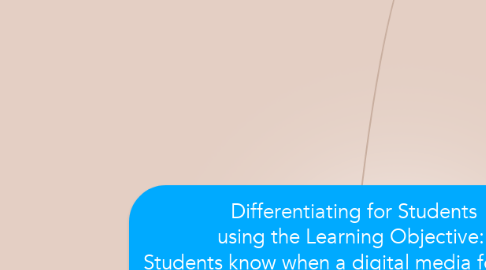
1. Readiness Levels
1.1. Level 2- Emerging (below classroom level)
1.1.1. These students are below classroom level. How can we differentiate for them?
1.1.1.1. 21st century technology: Power Point
1.1.1.1.1. Level 2 students won't always understand verbal instruction. Listening is often the last branch of English that students understand. For this reason, I will always use a PPT to supplement my verbal communication. The PPT will include pictures.
1.1.1.2. Handout
1.1.1.2.1. Provide a list of "sentence starters" to help these students.
1.1.1.2.2. Help students follow along with the lesson and understand the Key Points (ie: "obtain clarity", "thoroughness", & "provide reasoning").
1.1.1.3. Frayer Model (McCarthy, J., n.d.)
1.1.1.3.1. The Frayer Model is a template that helps with vocabulary and the understanding of concepts. For this specific objective, I especially like the "draw a picture" part. That will get the students thinking about digital media.
1.2. Level 5- Bridging (above classroom level)
1.2.1. These students are above classroom level. How can we differentiate for them?
1.2.1.1. Learning Centers (McCarthy, J., n.d.)
1.2.1.1.1. With "learning centers" students complete a portion of the "stations." To meet this particular objective, I would have the Bridging students complete the hardest tasks in the bunch.
1.2.1.2. Frayer Model (McCarthy, J., n.d.)
1.2.1.2.1. The Frayer model is a template that helps with vocabulary and understanding concepts. For Bridging students, the Frayer model will give them a chance to express their ideas fully.
1.2.1.3. 21st Century Technology:
2. Interests
2.1. Pop Music
2.1.1. These students are really motivated by pop music. It's not just that they like it, it's that most of there waking moments revolve around thinking about pop music. How can we differentiate for them?
2.1.1.1. Promote Choice
2.1.1.1.1. This blog post details 6 different ways teachers can promote choice in their classrooms.
2.1.1.1.2. But limit the options (McCarthy, J., 2014).
2.1.1.2. 21st Century Technology: Use clips that incorporate pop music in the lesson.
2.1.1.2.1. There are so many ways to show how digital media is used so there's no excuse for not providing interesting videos for this group of students.
2.2. Getting a Job
2.2.1. These students are worried about their future. Sometime they focus too much on the TOIEC test, because they are really worried how the test will effect their ability to get a job. How can we differentiate for them?
2.2.1.1. Don't focus on the summative assessment.
2.2.1.1.1. Make grades an afterthought. Instead, focus on formative assessment and assuring these students that they know the information, and most importantly, know how to apply it.
2.2.1.1.2. Include a vocabulary list on a handout. These words won't be tested in class. Vocabulary is a good way to increase a student's fluency and also prepare them for the TOIEC test.
2.2.1.2. 21st Century Technology: Use clips that incorporate business/meetings/work presentations to show that digital media can be used in ALL kinds of presentations, not just journalism.
2.2.1.2.1. There are so many ways to show how digital media is used so there's no excuse for not providing interesting videos for this group of students.
3. Learning Profiles
3.1. Group Learning
3.1.1. Some students work better in groups. We might be able to say that extroverted students learn better when they are able to work with others during the school day. How can we differentiate for them?
3.1.1.1. Most classes, if for only a brief time, have some kind of group work. Sometimes during solo activities, I might allow students to work together to complete a task.
3.2. Independent Learning
3.2.1. Some students work better alone. We might say that introverted students learn better when they have independent time to think through and analyze thoughts alone. How can we differentiate for them?
3.2.1.1. Because most classes are at least partially made up of group work, I will let students work alone if they make a good case for it. I, myself, am introverted and complete almost all work alone.
3.2.1.2. Provide quiet spaces in the classroom for introverted students to "get away."
3.2.1.3. 21st century technology: headphones! In the quiet area students can choose to wear headphones.
